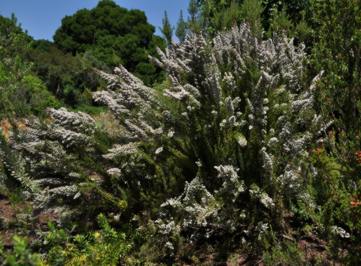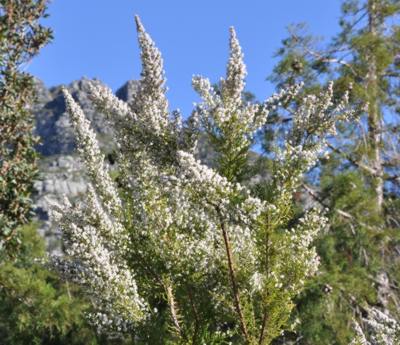Erica scabriuscula
Erica scabriuscula Lodd.
Family: Ericaceae
Common names: none recorded
Introduction
Erica scabriuscula is a most impressive, hardy erica that grows into a large bush covered with thousands of small white to pale pink flowers through the summer months. This species provides an exquisite display with its profusion of flowers that transform the bush into a crown of colour.

Description
Description
Erica scabriuscula is a large, erect shrub developing into a very large bush up to 2 or 3 m high and sometimes even into a small tree up to 5 m tall in protected or semi-shaded valley habitats. It is well branched and covered with very small, dark green leaves that are covered with tiny glandular hairs giving it a fine, soft texture. This species produces a profusion of small white or sometimes pale pink, rounded to urn-shaped flowers.

Conservation Status
Status
Erica scabriuscula is a widely spread southern Cape species common along the mountains and coastal plains, and as such is not threatened and has been classified in the Red List as Least Concern.
Distribution and habitat
Distribution description
Erica scabriuscula occurs primarily from the eastern Langeberg, along the Outeniqua and Tsitsikamma mountain ranges as well as along the coastal plains and valleys from Mossel Bay to Humansdorp in the southern Western and Estern Cape. It also occurs in the Swartberg range near Oudtshoorn. This species is found on moist flats and lower mountain slopes where it tolerates full sunlight, and under such conditions has a more compact habit reaching a height of about 1.2 m. It is however more commonly found in cool valleys and along forest margins where it grows into a large bush 3-5 m tall.
Derivation of name and historical aspects
History
This species has hairy leaves and branches which give the plant its characteristic roughness when touched. This feature gave rise to its specific name scabriuscula, meaning slightly rough to the touch, from the Latin words scaber meaning rough and usculus indicating the diminutive.
Ecology
Ecology
Erica scabriuscula prefers cooler, moister south-facing slopes and forest margins. It is a large species that is able to compete in tall fynbos often found in the protected, semi-shaded valleys and slopes of the southern Cape. It is also able to survive quite happily in more exposed areas where, however, it does not grow as tall. It grows in poor, well-draining, acidic soils derived from weathered quartzite.
It is a hardy species and relatively long-lived for a fynbos species. Its flowers are small and appear to be mainly pollinated by bees and flies. The anthers are `aristate', which means they have appendages called awns. The insect visiting the flowers pushes its mouthparts (proboscis) into the flower in search of nectar and, in doing so, disturbs the anthers which are held in a ring by the awns. Pollen is released and covers the insect's proboscis and is then transferred to the next flower effecting pollination.
Seeds may germinate if there is enough moisture and light and not too much competition from other plants. Normally they germinate after fire has cleared the vegetation.
Uses
Use
Erica scabriuscula is a very showy species when in flower. It is recommended as a strong-growing, reliable garden plant and is easy to maintain in average Mediterranean conditions and will also grow well as a large pot plant. This species is ideal for a fynbos garden or even for a semi-shade garden as long as it gets at least half a day of direct sunlight.

Growing Erica scabriuscula
Grow
Erica scabriuscula is easily grown from [fresh] seed which remains optimally viable for approximately five years after which it begins to lose its viability by degrees. Seed should be sown in late summer or autumn. Germination is greatly enhanced by the application of smoke which mimics the conditions in nature. Seed is sown onto a well-draining, slightly acidic growing medium consisting of a combination of river sand and well decomposed pine bark in roughly equal proportions. Seed germinates in about six weeks, with seedlings emerging as tiny, delicate plantlets that must be lightly watered with a watering can. Let the seedlings grow to about 10 mm tall before pricking them out into small individual pots. Young seedlings are encouraged to grow by feeding them every week with a diluted organic fertilizer. Seedlings grow slowly and will only be big enough after twelve months when they may be planted into the garden. It is advisable to plant out during the cooler autumn or early winter months to allow the plants to establish before the onset of the dry summer.
Erica scabriuscula is rooted from cuttings in autumn or spring in multi-trays on heated benches under mist spray. Select small tip or heel cuttings about 20-30 mm long, taking thin wood from the previous season's growth. Heel cuttings are preferred, a procedure in which a short side shoot is removed from the stem. The base of the cutting is treated with a rooting hormone for semi-hardwood cuttings which are then placed into a rooting medium of 50 : 50 fine milled bark and polystyrene or perlite pellets.
This species grows into a large bush and therefore should be planted where there is enough space for it to expand into. A good measure is a radius of at least 2 m. It is not necessary to prune it if grown in an open garden bed. It will grow near the sea as long as it is protected from direct exposure to strong salt-laden winds. A good watering once a week during summer months should suffice. This species should provide a good show for at least 10 years and probably many more after that.
Erica scabriuscula can be grown in a large container, provided that the correct, well-draining growing medium is provided. Fynbos planting medium is made up of a combination of equal parts composted pine bark or pine needles and river sand. A little (20%) loam may also be added. It is a woody species, so regular pruning is recommended to keep the plants well branched and compact. Plants that are pruned are more presentable, last longer and produce more flowers.
Erica plants are adapted to living in poor soils, but, for best results, should be regularly fed with diluted organic liquid or small amounts of organic pellet fertilizers.
References
- Goldblatt, P. & Manning, J.C. 2000. Cape plants. A conspectus of the Cape flora of South Africa. Strelitzia 9. National Botanical Institute, Pretoria and Missouri Botanical Garden.
- Schumann, D. (Dolf) & Kirsten, G. (Gerard) 1992. Ericas of South Africa . Fernwood Press, Vlaeberg, Cape Town.
- http://www.sanbi.org/biodiversity/reddata.htm
Credits
Anthony Hitchcock
Kirstenbosch National Botanical Garden
December 2012
Plant Attributes:
Plant Type: Shrub
SA Distribution: Western Cape
Soil type: Sandy
Flowering season: Sporadic/All year
PH: Acid
Flower colour: White, Pink
Aspect: Full Sun, Morning Sun (Semi Shade)
Gardening skill: Easy
Special Features:
Horticultural zones







Rate this article
Article well written and informative
Rate this plant
Is this an interesting plant?
Login to add your Comment
Back to topNot registered yet? Click here to register.